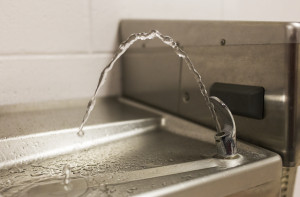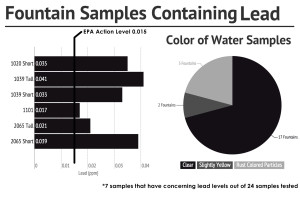H2O or H2No? Rusty, Discolored Water Has Concerning Lead Levels
February 12, 2015

Hundreds of students drink from school water fountains, unaware of the quality of the water that they are putting into their bodies – not knowing whether or not they are consuming is rusty, lead-filled water.
Samples were collected from 24 RHS water fountains at 10:45 a.m. on Jan. 26. Seven of them had a visibly yellow tint to them with floating solids in the water and settled solids at the bottom of the sample container. Samples were sent to Sheppard T. Powell Associates, LLC labs.
Water from fountains next to rooms 1020, 1039, 1101, and 2065 had lead amounts that surpassed the EPA action level of 0.015 ppm.
According to the World Health Organization, lead can damage the nervous and reproductive systems and the kidneys, and is especially unsafe for young children and pregnant women.
Jim Roenick, a water treatment contractor and chemist for Georgetown University, helped process and interpret the samples. He explained that the yellow tint usually comes from suspended metals in the water (iron, copper and/or other metals). “Whether it’s a copper pipe or a steel pipe, it’s going to corrode. So now, when you turn the water fountain on, you get those products in the water,” Roenick said.
The more a water fountain is used, the more the water gets to run and metals are flushed out of the system. For the less frequently used fountains, the water sits inside the pipes for longer periods of time, increasing the chances that those pipes will rust. These metals then leach into the water that the users will consume, Roenick explained.
Roenick also explained that the farther a fountain is from the main water line and the more twists and turns the pipes take, it is more likely the water will sit and rust the pipes, creating suspended particles in it.
RHSa�� water, along with most MCPS school water, comes from the Washington Suburban Sanitary Commission (WSSC).
Brian Mullikin, environmental team leader in MCPS Division of Maintenance explained that in MCPS, the only school using filters on water fountains is Seneca Valley HS, due to a specific case in the school’s water.
The filters remove odors from the water along with certain suspended particles.

Jerry Irvine, public affairs man ager for WSSC said, “Here at WSSC, we’ve never had a water quality issue and we’ve always met the standards that the EPA gives.”
While some may think that switching to bottled water exclusive ly is a safe bet, Irvine said that bottled water falls under FDA guidelines, not EPA guidelines.
“The first issue is that while there is some testing of bottled water here and there, they don’t fall under the same EPA guidelines, they fall under different guidelines under the FDA,” Irvine said. “It’s not to say bottled wa ter isn’t safe to drink but it is not as stringently tested as tap water.”
The problem with RHS fountain water is not tap water from WSSC per se, but the individual fountain units themselves as shown in the highly varying results between foun tains even on the same floor. There are no filters in the water coolers, and maintenance does not monitor the in side of the water fountains for piping maintenance.
Principal Billie-Jean Bensen re ferred all questions regarding RHSa�� water quality to building services.
Victor Bhandari, RHSa�� director of facilities, said, “We just clean the top of the water fountains just to keep it clean, but inside – the mechanical part – no.”
With higher testing and mainte nance, this problem can be resolved, according to Roenick and Mullikin. Filters can be installed in RHSa�� cur rent units. These are very simple to connect and relatively inexpensive, but flushing the water fountains each morning is the simplest, most effective solution according to Roenick.
As stated before, samples from this experiment were only collected during one time during the day, one day out of the entire school year. Al though the conclusion of the test re sults are therefore limited, imagine if someone drank from the fountain, not knowing that it is safest to let the wa ter run for at least 30 seconds to filter the metals; he would simply drink it like everyone else, uneducated about the possibility of concerning metals in the water.
Junior Emily Gee said, “The water in the fountains is okay, I mean I can drink it and anyone can, since they won’t die from it, but sometimes it tastes kind of funky.”
The last tests MCPS conducted on a large scale in all schools was seven years ago, checking all water sources in reaction to a scare in D.C. Public School’s water. Mullikin said, “Historically, the only thing WSSC has done in terms of water quality on a large scale in all the schools was in 2004 to 2008, and they tested all the schools for lead in all facilities.”
According to Mullikin, the only tests that are currently being con ducted are in newly built schools for lead, nothing else.
“You test it, and if it’s below EPA action levels, you never test it again. What’s recommended is a flushing protocol where building services will flush them every morning for 15 min utes,” Mullikin said. “It’s a recom mended protocol, not a required pro tocol from the EPA for schools. What that does is flush out any matter sit ting in the pipes over the weekend and you flush it out before drinking.”
Mullikin also stated that if there is a problem with the water’s taste or color coming from the school’s water fountains, WSSC is available to con duct a test on the water and react ac cordingly.
Right now, there are a few things you as a consumer can do before drinking from public fountain water. Always let the water run for a minute, and if possible use a clear water bottle to see if the water has a visible yellow tint or suspended matter. Go to water fountains that are more frequently used due to their higher flow rate or popularity, decreasing the probability of water sitting in the pipes and col lecting rust.
Lastly, the best way to fix RHS water fountains is to talk to the people who should fix them: maintenance. If the water tastes odd, as users, stu dents and staff should contact an ad ministrator or a maintenance person in order to resolve this issue.



